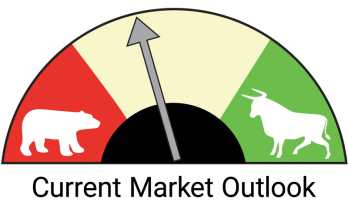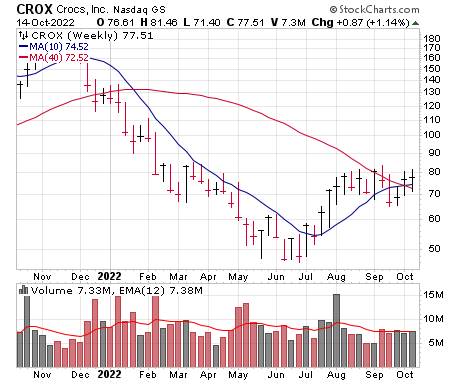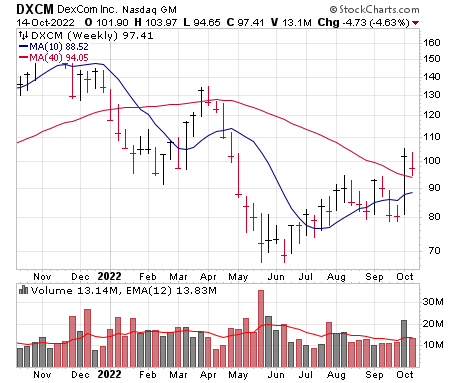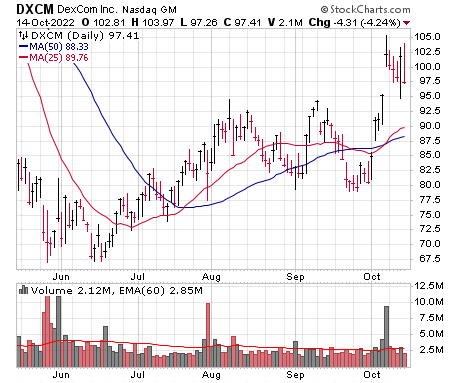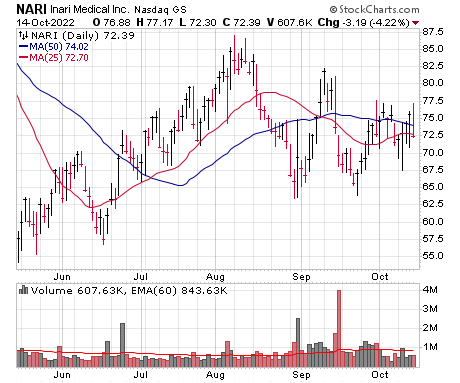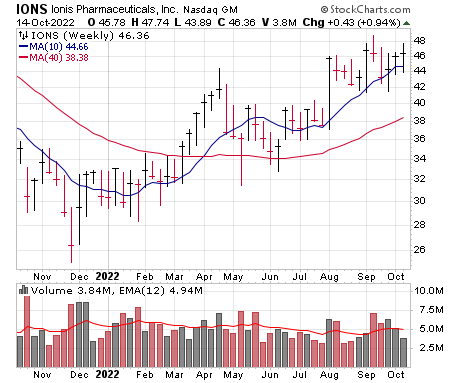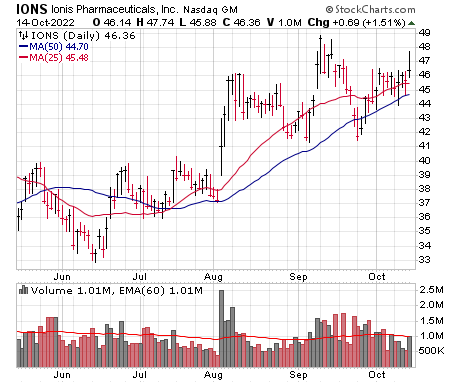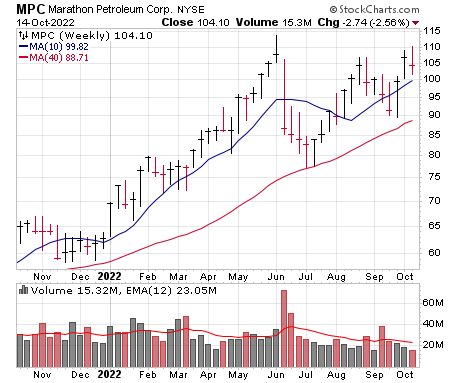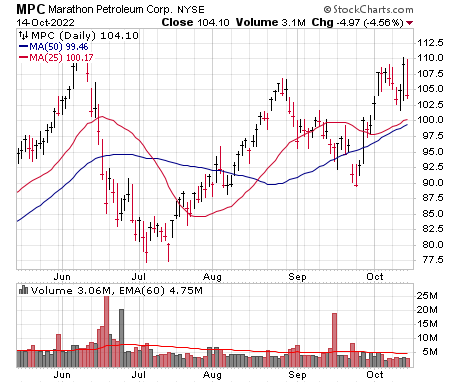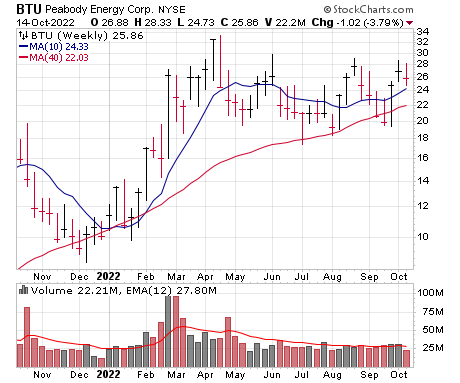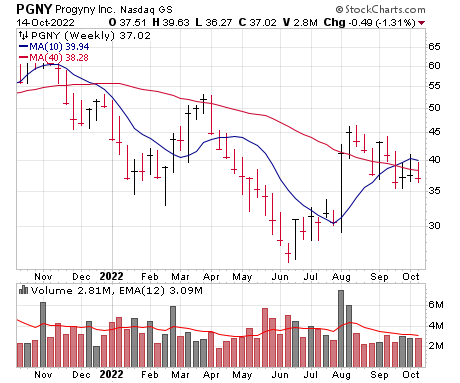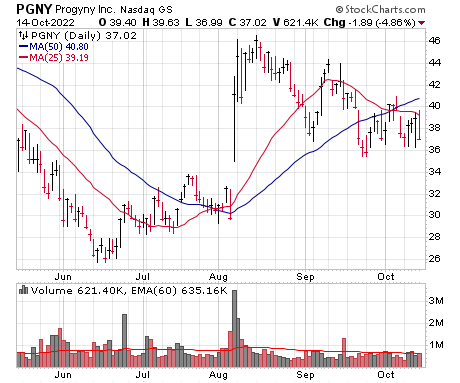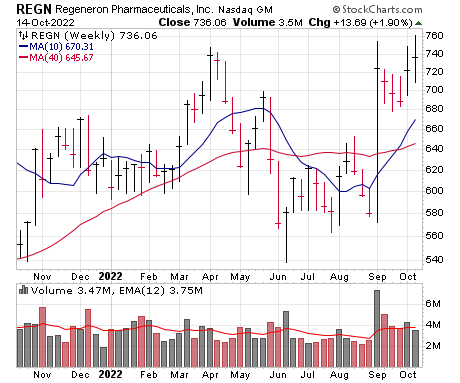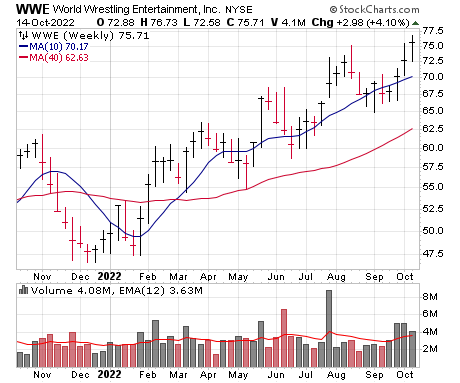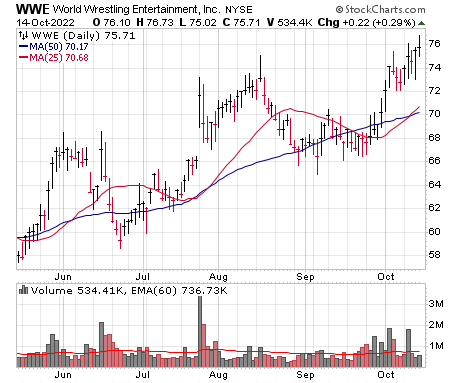Stay Defensive—and Flexible
Last week was another doozy for the bulls, with the major indexes suffering a good-sized decline and many growth stocks taking it on the chin (some fast-moving growth funds were down 7%-plus). With the major evidence still pointed down, there’s not much to do: We continue to advise holding plenty of cash and doing little on the buy side—and when you do buy, to keep positions small and to pick your spots carefully. That said, it’s also important to remain flexible, as there remains plenty of underlying potential positives, including another round of hugely pessimistic sentiment measures (eight straight weeks of outflows from equity funds and ETFs is somewhat rare) and a positive divergence in the broad market (the peak in new lows during this downleg came three weeks ago). As we’ve written before, if something actually goes right in the world (what a concept!), it’s possible the bulls could make a run at things, but we have to see it for more than a day or two to believe it. Our Market Monitor remains at a level 3.
This week’s list actually has a lot of names that look poised for intermediate-term moves … if the market can get out of its own way. Our Top Pick is Dexcom (DXCM), which has a story that remains great, a new product next year and four months of positive momentum on the chart. It’s one to watch, or if you’re aggressive, to nibble on if it dips.
| Stock Name | Price | Buy Range | Loss Limit |
| Acadia Healthcare (ACHC) | 82 | 79-81 | 72-73 |
| Crocs (CROX) | 78 | 76-79 | 64-66 |
| Dexcom (DXCM), ★ TOP PICK ★ | 100 | 94.5-97.5 | 82-84 |
| Inari Medical (NARI) | 77 | 78-80 | 66-68 |
| Ionis Pharm (IONS) | 47 | 44-45.5 | 39-40 |
| Marathon Petroleum (MPC) | 105 | 101-104 | 90-92 |
| Peabody Energy (BTU) | 27 | 25.5-27 | 21.5-22.5 |
| Progeny (PGNY) | 39 | 41-43 | 34-36 |
| Regeneron Pharm (REGN) | 737 | 720-740 | 668-680 |
| World Wrestling (WWE) | 76 | 72-74 | 65-66 |
STOCK 1
Acadia Healthcare (ACHC)
| Price | Buy Range | Loss Limit |
| 82 | 79-81 | 72-73 |
Why the Strength
Mental illness is one of the most common health afflictions in the U.S., with more than one in five Americans experiencing a mental disorder in any given year. Acadia (covered in the July 18 issue) specializes in providing care for such diseases, operating 230 facilities across 40 states that treat a broad spectrum of behavioral problems and provide acute psychiatric inpatient hospitalization, medication-assisted treatment and an array of outpatient options. The prevalence of mental health disorders has exploded since the pandemic began, with a recent report by the World Health Organization estimating a 25% increase in anxiety and depression worldwide since 2020. Acadia sees a $30 billion opportunity in the mental health treatment market and has aggressively expanded its footprint this year to address it, including plans to add 600 new beds at its existing facilities, two new facilities with joint venture partners and at least six comprehensive treatment centers. (Most recently, the company broke ground on a new behavioral health treatment and teaching hospital in Michigan with a 192-bed capacity as part of its expansion plans.) Federal reimbursement from Medicare and Medicaid represents 65% of Acadia’s revenues, which provides some stability but also limits the amount it can charge for its services. However, a major Wall Street bank just included Acadia among its highest conviction stock picks for the rest of 2022, predicting more than 10% annual EBITDA growth over the next five years, “even when considering potential pressure from Medicaid reimbursement.” When the firm reports Q3 on October 31, analysts also expect top- and bottom-line growth of around 10%, and the fact that Acadia’s business is safe from the world’s worries (Fed rate hikes and economic issues) is a big plus.
Technical Analysis
ACHC has actually been counter-trending the market for much of this year, hitting a correction low back in February (part of a nine-month cooling off phase from its huge post-pandemic run) and rallying to a new peak in April near 75, and after a correction into June, a high in the mid 80s last month. Now AHCH is chopping sideways, again resisting the worst of the market’s selloff. If you’re aggressive, you could nibble on dips and use a stop in the low 70s.
| Market Cap | $7.32B | EPS $ Annual (Dec) | |
| Forward P/E | 26 | FY 2020 | 2.43 |
| Current P/E | 28 | FY 2021 | 2.56 |
| Annual Revenue | $2.45B | FY 2022e | 3.12 |
| Profit Margin | 11.8% | FY 2023e | 3.40 |
| Qtrly Rev | Qtrly Rev Growth | Qtrly EPS | Qtrly EPS Growth |
| ($M) | (vs. yr-ago-qtr) | ($) | (vs.yr-ago-qtr) |
| Latest qtr | 652 | 12% | 0.84 | 18% |
| One qtr ago | 617 | 12% | 0.67 | 43% |
| Two qtrs ago | 594 | 10% | 0.67 | -14% |
| Three qtrs ago | 588 | 7% | 0.72 | 6% |
STOCK 2
Crocs (CROX)
| Price | Buy Range | Loss Limit |
| 78 | 76-79 | 64-66 |
Why the Strength
Crocs is best known for the molded, many-holed plastic clogs originally favored by chefs and others who spend long hours on their feet. These days, Crocs is benefitting from people spending more time on the couch – the work from home crowd that doesn’t need to commute and dress up to office standards anymore. Sales in the latest quarter were up more than 50% to $965 million with an expanding gross margin that allowed EPS – after adjusting for a change in the business’ tax structure – to rise 45% to $3.24. Most of its sales continue to come from its namesake line of Crocs products – and the brand has been buoyant outside North America, with strong double digit growth in Asia, Europe and Latin America. But the company is also benefitting from its $2.5 billion acquisition of HEYDUDE, a line of casual footwear and slippers, which closed in February. Early results show the purchase to be a good one, with the brand’s sales up 96% year over year at a better-than-expected $232 million in the second quarter. There are a lot of headwinds right now –inflation, the strong dollar which affects international sales, and supply chain hiccups – but Crocs is executing well. The company sees the Crocs brand sales totaling $2.6 billion for the year, up about 11%, with HEYDUDE coming in for the company $870 million (about $960 for the brand’s full year), which should produce EPS of $10. Management credits a lot of work in digital marketing for making Crocs hip and fresh again – pretty good considering its first clog was rolled out 20 years ago. The low valuation (8x earnings) is another plus. Earnings are due November 3.
Technical Analysis
After a monstrous post-pandemic advance, CROX had a horrid decline when the bears took over, falling from a peak near 180 to a low of 47 in May. But that was basically the low, and shares did rally nicely with the market in the summer. More encouragingly, CROX has held up well during the past couple months of market implosion, with shares not far from multi-month highs. You could nibble here if you’re aggressive, or just watch CROX for an eventual rally above 84 with a more supportive market.
| Market Cap | $4.80B | EPS $ Annual (Dec) | |
| Forward P/E | 8 | FY 2020 | 3.22 |
| Current P/E | 8 | FY 2021 | 8.32 |
| Annual Revenue | $2.84B | FY 2022e | 10.06 |
| Profit Margin | 20.9% | FY 2023e | 10.60 |
| Qtrly Rev | Qtrly Rev Growth | Qtrly EPS | Qtrly EPS Growth |
| ($M) | (vs. yr-ago-qtr) | ($) | (vs.yr-ago-qtr) |
| Latest qtr | 965 | 51% | 3.24 | 45% |
| One qtr ago | 660 | 43% | 2.05 | 38% |
| Two qtrs ago | 587 | 43% | 2.15 | 103% |
| Three qtrs ago | 626 | 73% | 2.47 | 163% |
STOCK 3
Dexcom (DXCM) ★ TOP PICK ★
| Price | Buy Range | Loss Limit |
| 100 | 94.5-97.5 | 82-84 |
Why the Strength
Dexcom is a long-term growth story, as it’s one of the big players in continuous glucose monitoring (CGM) systems—they’ve always represented a big advancement over intermittent monitoring (which simply doesn’t pick up on enough times when glucose is out of the target range, hurting health results) for intensive insulin and type 2 diabetics, and there’s plenty of room for growth in the U.S. (all CGM users total less than a third of potential reimbursed patients) and internationally (a market that could be 3x the size of the U.S.), but adoption is growing fast as the pharmacy channel booms (easier for PCPs to prescribe) and technology races ahead: Dexcom’s G6 (released in late 2018) was a huge step forward, with no finger sticks necessary, while Dexcom ONE (can be used by any Type 1 or Type 2 diabetic at least two years old; measures glucose levels just under the skin and transmits to your smartphone) is gaining traction overseas as a cash pay option. But the upcoming driver should be the G7, which has even better accuracy than the G6, is 60% smaller and much lighter, is fully disposable and has a quicker warmup time, all of which should attract even more patients into the fold. Long-term, Dexcom is aiming to expand its capabilities into new areas (pre- and gestational diabetes, etc.), while a recent decision by Medicare to expand coverage for CGMs could double the U.S. market in the near-term. Numbers-wise, sales growth has been solid and should remain in the 20% area going forward, while earnings growth should accelerate into 2023. There is competition from Abbott and the like, but there’s no question Dexcom is one of the big leaders in the space.
Technical Analysis
DXCM has a history of staging big, long advances but then falling into big, long corrections and consolidations, and it’s clearly in the latter stage now—shares peaked late last year in the 185 area and slipped under 70 at its nadir this spring, with a modest rally into August. DXCM did hold up pretty well for a couple of months, but the Medicare coverage decision helped the stock spike earlier this month and hold near its 40-week line. It’s hard to buy anything in this environment, but if you want in, a bit more of a pullback could present an opportunity to nibble.
| Market Cap | $38.5B | EPS $ Annual (Dec) | |
| Forward P/E | 123 | FY 2020 | 0.78 |
| Current P/E | 159 | FY 2021 | 0.67 |
| Annual Revenue | $2.67B | FY 2022e | 0.80 |
| Profit Margin | 10.0% | FY 2023e | 1.11 |
| Qtrly Rev | Qtrly Rev Growth | Qtrly EPS | Qtrly EPS Growth |
| ($M) | (vs. yr-ago-qtr) | ($) | (vs.yr-ago-qtr) |
| Latest qtr | 696 | 17% | 0.17 | -11% |
| One qtr ago | 629 | 25% | 0.08 | 0% |
| Two qtrs ago | 698 | 23% | 0.17 | -26% |
| Three qtrs ago | 650 | 30% | 0.22 | -8% |
STOCK 4
Inari Medical (NARI)
| Price | Buy Range | Loss Limit |
| 77 | 78-80 | 66-68 |
Why the Strength
We have some unique medical outfits in this issue that offer highly differentiated solutions for a big market that’s underserved, and Inari Medical is one of them. The story is based on the difference between removing clots from arteries vs. the veins—arterial systems have higher flow and pressure and softer clots, while venous systems are low flow and pressure with large amounts of hard clots (usually in the lower leg, thigh or pelvis) adhered to a wall. So what? Well, to this point, most venous clot removal procedures use repurposed arterial clot products, with predictably so-so results; venous clots also are poor options in general for drugs (called thrombolytics), which are expensive anyway. That’s where Inari comes in, with a variety of products under the ClotTriever and FlowTriever (for larger clot hauls) brands that eliminate the need for drugs, increase safety (major bleeding events occur less than 1% of the time), boost hospital efficiency (no ICU stays, can be treated in a single session; net-net, hospitals make more money using these rather than the old methods) and work on any age clot (acute or chronic). All in all, it’s a target market that conservatively totals 100,000 procedures annually, and Inari is steadily gaining share—sales growth is decelerating a bit but still remains rapid (46% in Q2), while losses are set to shrink next year. It’s not likely to be a triple-digit grower, but if management pulls the right strings and the sales force expands, there’s no reason Inari won’t get a lot bigger over time. The next big event is the Q3 report, which is due November 2.
Technical Analysis
NARI came public in May 2020 and had a great first few months, zooming to a high near 125 in February 2021, before bumping downhill for about 15 months, bottoming near 50 in May of this year. The rebound from there was fairly solid, taking NARI above its 40-week line, and while the past 10 weeks have been tedious, shares have actually held up relatively well even as the market has caved in. (Interestingly, fund ownership is up nicely despite this year’s bear, 516 now vs. 415 at year-end 2021.) NARI is worth watching, though if you want to buy we’d favor aiming to do so on a powerful leap over 78 and using a loose leash.
| Market Cap | $3.91B | EPS $ Annual (Dec) | |
| Forward P/E | N/A | FY 2020 | 0.26 |
| Current P/E | N/A | FY 2021 | 0.18 |
| Annual Revenue | $336M | FY 2022e | -0.70 |
| Profit Margin | N/A | FY 2023e | -0.22 |
| Qtrly Rev | Qtrly Rev Growth | Qtrly EPS | Qtrly EPS Growth |
| ($M) | (vs. yr-ago-qtr) | ($) | (vs.yr-ago-qtr) |
| Latest qtr | 92.7 | 46% | -0.19 | N/A |
| One qtr ago | 86.8 | 51% | -0.06 | N/A |
| Two qtrs ago | 83.2 | 71% | 0.02 | -85% |
| Three qtrs ago | 72.9 | 88% | -0.06 | N/A |
STOCK 5
Ionis Pharm (IONS)
| Price | Buy Range | Loss Limit |
| 47 | 44-45.5 | 39-40 |
Why the Strength
Ionis Pharmaceutical can brag of having the first blockbuster RNA-based therapy. Marketed by Biogen, Spinraza treats spinal muscular atrophy, selling $904 million in the first half of this year into what is still seen as a growing market opportunity. Ionis’ therapies alter production of specific toxic or “mutant” proteins in the body, which means the company is able to develop drugs for afflictions that otherwise are very hard to treat. The company has three treatments in late-stage development, two of which have the potential to themselves be blockbusters (more than $1 billion in sales): Eplontersen reduces production of the TTR protein, which leads to fatal diseases amyloid transthyretin cardiomyopathy (ATTR-CM) and amyloid transthyretin polyneuropathy (ATTR-PN). Ionis expects to file its new drug application by year-end and has inked a deal with AstraZeneca to market it. Ionis says Eplonteresen has the potential for multibillion-dollars of sales. The second big drug to watch is Olezarsen, which treats the production of a protein that puts people at risk for acute pancreatitis and cardiometabolic disease. Phase III data will be released in 2023, and Ionis says it can sell over $1 billion if approved. A third treatment, Donidalorsen, potentially could be best-in-class for treating hereditary angioedema (HAE), which is a rapid swelling attack of blood vessels caused by an improperly function protein. With more than dozen other drugs in mid- or late-stage development, Ionis effectively has created a new class of therapies through its RNA focus. The company is on track to produce revenue of $592 million this year, though with a loss of $2.61 a share forecasted. Ionis is well-capitalized with more than $2 billion net cash on hand.
Technical Analysis
IONS hit a long-term peak of 85 in April 2019 on Spinraza enthusiasm, but with that therapy priced in, shares sold down to 25 in December of last year. But the stock began to show signs of a new uptrend in the spring, and after a tidy-looking base, broke out with many biotechs in early August—and shares have actually held those gains since despite the poor market. IONS is a good name for your watch list; if you want to grab shares, we advise aiming for dips.
| Market Cap | $6.57B | EPS $ Annual (Dec) | |
| Forward P/E | N/A | FY 2020 | 1.04 |
| Current P/E | 77 | FY 2021 | 0.84 |
| Annual Revenue | $849M | FY 2022e | -2.61 |
| Profit Margin | N/A | FY 2023e | -2.62 |
| Qtrly Rev | Qtrly Rev Growth | Qtrly EPS | Qtrly EPS Growth |
| ($M) | (vs. yr-ago-qtr) | ($) | (vs.yr-ago-qtr) |
| Latest qtr | 134 | 6% | -0.56 | N/A |
| One qtr ago | 142 | 28% | -0.27 | N/A |
| Two qtrs ago | 440 | 52% | 1.76 | 93% |
| Three qtrs ago | 133 | -17% | -0.34 | N/A |
STOCK 6
Marathon Petroleum (MPC)
| Price | Buy Range | Loss Limit |
| 105 | 101-104 | 90-92 |
Why the Strength
Marathon is a leading, integrated downstream energy company and operator of the nation’s largest refining system, with a capacity of nearly three million barrels of oil per day. Marathon’s marketing system includes branded locations across the U.S., including Marathon brand retail fuel outlets. Demand for gasoline and diesel have been steadily improving this year, which Marathon attributes to “the removal of globally imposed mobility restrictions and the pent-up desire to travel.” The company reported stellar results for Q2, obliterating Wall Street’s expectations as refining margins tripled. Revenue of $54 billion soared 82% from a year ago, while per-share earnings of $10.61 beat estimates by a mile. Marathon’s refining and marketing margin (revenue less the cost of refinery inputs and purchased products) was $37.54 per barrel in the quarter, up an eye-popping 200% from a year ago, while it operated at near-max capacity. These factors helped the company produce adjusted EBITDA of over $9 billion, as the crude oil refining system ran at full utilization to meet demand. To be fair, no one expects these record margins to continue, but they could prove stickier than many think—management said demand remains “resilient” in Q3 and expects throughput of just under three million barrels in the quarter. The company also affirmed its commitment to shareholder returns, with the share count down a whopping 18% from a year ago, and firm has a decent dividend, too (2.2% annual yield). Analysts see earnings falling back to Earth next year, but (a) they’re likely to remain giant and (b) those estimates are likely too low.
Technical Analysis
MPC took the second half of last year off, mostly consolidating its big 2020 advance, but it hit the ground running in 2022, breaking out the first week of the year and blowing off into June. The correction with the energy group was sharp, but MPC did hold its 40-week line and began to repair the damage—shares bounced to 107 in August, pulled back in September, then briefly nosed to a higher high last week. Shares are very volatile, but if you want to take a shot, you could target an entry down a couple of points from here.
| Market Cap | $52.1B | EPS $ Annual (Dec) | |
| Forward P/E | 4 | FY 2020 | 5.29 |
| Current P/E | 8 | FY 2021 | -10.79 |
| Annual Revenue | $161B | FY 2022e | 23.29 |
| Profit Margin | 10.5% | FY 2023e | 12.47 |
| Qtrly Rev | Qtrly Rev Growth | Qtrly EPS | Qtrly EPS Growth |
| ($M) | (vs. yr-ago-qtr) | ($) | (vs.yr-ago-qtr) |
| Latest qtr | 54.2 | 82% | 10.61 | N/A |
| One qtr ago | 38.4 | 68% | 1.49 | N/A |
| Two qtrs ago | 35.6 | 96% | 1.30 | N/A |
| Three qtrs ago | 32.6 | 86% | 0.73 | N/A |
STOCK 7
Peabody Energy (BTU)
| Price | Buy Range | Loss Limit |
| 27 | 25.5-27 | 21.5-22.5 |
Why the Strength
After years of being shunned as a pollutant, coal has made a stunning comeback as a key fuel source this year. Global coal demand for 2022 is expected to match the record high reached nearly a decade ago, thanks to skyrocketing natural gas costs and a decline in Russian natural gas exports to Europe. A major player in this space is Peabody, a global pure-play coal company focused on mining and selling coal used in steelmaking (coking) and electricity generation (thermal). Peabody also leads in U.S. in coal output, with a 20% share in total production and the world’s largest private-sector coal company. A multi-year decrease in domestic coal production has resulted in tight supplies, allowing Peabody to realize soaring prices, which are driving the bottom line through the roof. While the company provides coking coal for industrial steelmakers, around 60% of its sales are to thermal customers, and this is where most of the demand is expected going forward. Another positive for Peabody is an ongoing strike by South Africa’s miners, which is taking a serious toll on coal exports to Europe in the midst of that continent’s energy crisis (the company sells coal to Europe from its Powder River Basin mine) and keeping prices extraordinarily high. On the financial front, Peabody saw sales of $1.3 billion in Q2 that were 83% higher from a year ago, along with the highest quarterly adjusted EBITDA in more than a decade. Its windfall earnings have enabled it to reduce its debt load by over $200 million (around 20% of the total) in the last year, and it’s now holding more cash than debt. Moreover, the company is in merger talks with an Australian rival which could create a combined company worth $6 billion. There’s a lot to like about this story, and analysts see Q3 revenue jumping 90%.
Technical Analysis
BTU was close to going under in 2020, when the stock reached just 80 cents per share, but as the industry has improved, the stock has come back from the dead. The recent action has been very hectic, with a peak near 33 in April and a very wide trading range since—but BTU has held its 40-week line and is beginning to show accumulation as earnings estimates remain buoyant. If you want in, you could nibble here, though we’d prefer to watch and wait for a burst above 30 in a healthier market environment.
| Market Cap | $3.74B | EPS $ Annual (Dec) | |
| Forward P/E | 4 | FY 2020 | -18.99 |
| Current P/E | 5 | FY 2021 | 3.00 |
| Annual Revenue | $3.95B | FY 2022e | 5.89 |
| Profit Margin | 31.0% | FY 2023e | 5.98 |
| Qtrly Rev | Qtrly Rev Growth | Qtrly EPS | Qtrly EPS Growth |
| ($M) | (vs. yr-ago-qtr) | ($) | (vs.yr-ago-qtr) |
| Latest qtr | 1.32 | 83% | 2.55 | N/A |
| One qtr ago | 0.69 | 6% | -0.87 | N/A |
| Two qtrs ago | 1.26 | 72% | 3.90 | N/A |
| Three qtrs ago | 0.68 | 1% | -0.60 | N/A |
STOCK 8
Progeny (PGNY)
| Price | Buy Range | Loss Limit |
| 39 | 41-43 | 34-36 |
Why the Strength
We’ve been enamored of Progyny’s story for nearly two years, as it’s a health insurer with a new, far more productive way to help couples conceive—a huge, recession resistant industry. Current insurance options are usually add-ons to comprehensive plans, with high costs and often leading to higher-risk pregnancies, lower pregnancy success rates and, hence, lots of stress and poor mental health. Progyny is effectively redefining the market with the only fully-managed fertility offering, with coverage for the latest technologies; an integrated pharmacy solution; access to the largest network of fertility specialists over a few hundred locations; and flexible all-inclusive bundles, too. The proof is in the results, as Progyny’s clients sport 16% better pregnancy rates, a 26% lower miscarriage rate and a whopping 72% fewer multiples rate—and that, in turn, has tons of big, self-insured companies signing up (265 at the end of last sign-up season) and sticking around (near 100% retention) with the company. And Progyny’s potential from here remains gigantic, as it sees its target U.S. market at around 8,000 corporations and it believes fertility offerings are valued higher by the millennial generation that’s flooding the workforce. (Only 2% of U.S. babies involve some sort of reproductive assistance, compared to 10% in other countries that have more robust insurance options.) Usage of the firm’s services dipped a bit during the pandemic but immediately snapped back, and the fundamental numbers remain excellent: In Q2, sales growth accelerated to 52%, while EBITDA (generally a better profitability measure for this firm) advanced 78%, and the future looks bright, with management saying in the Q2 conference call they received a record number of commitments early in the sign-up season. We like it.
Technical Analysis
PGNY topped with the market at 68 last November, tumbled as low as 26 in May and bounced for a few weeks with the market after that. But the bullish Q2 report (and conference call) helped the stock gap strongly, part of two straight weeks of big-volume buying. Since then, shares have sagged, but on light volume, and they haven’t caved in like so many names. Keep PGNY on your watch list, and if you’re aggressive, you could consider grabbing shares on a move north of 41.
| Market Cap | $3.42B | EPS $ Annual (Dec) | |
| Forward P/E | 206 | FY 2020 | 0.17 |
| Current P/E | 85 | FY 2021 | 0.66 |
| Annual Revenue | $617M | FY 2022e | 0.18 |
| Profit Margin | 4.5% | FY 2023e | 0.37 |
| Qtrly Rev | Qtrly Rev Growth | Qtrly EPS | Qtrly EPS Growth |
| ($M) | (vs. yr-ago-qtr) | ($) | (vs.yr-ago-qtr) |
| Latest qtr | 195 | 52% | 0.09 | -53% |
| One qtr ago | 172 | 41% | 0.05 | -67% |
| Two qtrs ago | 128 | 27% | 0.15 | 114% |
| Three qtrs ago | 122 | 24% | 0.17 | 143% |
STOCK 9
Regeneron Pharm (REGN)
| Price | Buy Range | Loss Limit |
| 737 | 720-740 | 668-680 |
Why the Strength
Regeneron is a biotech focused on neurotrophic factors—proteins that support the growth of neurons—and their regenerative capabilities. Last week was a busy one for the firm, which made headlines after presenting positive data for Dupixent, a treatment for allergic diseases that Regeneron has developed with its partner, Sanofi. Dupixent showed a significant remission of the allergic condition eosinophilic esophagitis (EoE) in children ages one to 11—the first drug to show positive results in this age group. Regeneron plans to submit the data to global drug regulators, starting with the FDA next year (Dupixent would be the first EoE treatment for patients under 12, if approved). Also last week, the FDA granted a priority review for Regeneron’s blockbuster eye medicine Eylea to treat Retinopathy of Prematurity in preterm infants (Eylea had U.S. net sales of nearly $6 billion last year), which goes along with recent positive clinical results for that drug that support it being a new standard of care for wet age-related macular degeneration and macular edema. And then there was a European regulator that recommended the expanded approval of the firm’s Libtayo drug as a monotherapy to treat adult patients with recurrent or metastatic cervical cancer and disease progression on or after platinum-based chemotherapy (the drug is already approved in the E.U. to treat patients with other types of cancers.). As for the numbers, earnings are taking a hit this year as some of Regeneron’s Covid-related businesses fade, but the bottom line should remain elevated and investors’ focus is on the myriad drivers going forward.
Technical Analysis
REGN tried to break free from a year-and-a-half-long base back in March but market weakness kept it from doing so and shares careened from a high of almost 750 to a low of 540 in June. It was still stuck in the mud until the Eyela trial results in September, which caused the stock to gap up hugely, and shares have actually nosed higher since then. If you want to nab some shares, you can nibble here with a stop near the 50-day line.
| Market Cap | $80.0B | EPS $ Annual (Dec) | |
| Forward P/E | 18 | FY 2020 | 31.47 |
| Current P/E | 12 | FY 2021 | 74.66 |
| Annual Revenue | $14.2B | FY 2022e | 41.26 |
| Profit Margin | 39.4% | FY 2023e | 43.34 |
| Qtrly Rev | Qtrly Rev Growth | Qtrly EPS | Qtrly EPS Growth |
| ($M) | (vs. yr-ago-qtr) | ($) | (vs.yr-ago-qtr) |
| Latest qtr | 2.86 | -44% | 9.77 | -62% |
| One qtr ago | 2.97 | 17% | 11.49 | 16% |
| Two qtrs ago | 4.95 | 104% | 23.72 | 149% |
| Three qtrs ago | 3.45 | 51% | 15.37 | 84% |
STOCK 10
World Wrestling (WWE)
| Price | Buy Range | Loss Limit |
| 76 | 72-74 | 65-66 |
Why the Strength
It’s not often that investors cheer the departure of a company’s successful, long-time chairman. But that’s exactly what happened when Vince McMahon, WWE’s CEO of 40 years, stepped down in July, paving the way for a leadership change that many see as a long-term positive. WWE, which is well known for its televised pro wrestling events, has transformed itself in recent years into a global integrated media and entertainment company, including forays into film making, American football and other businesses. But weekly televised wrestling shows are still the company’s calling card, with TV licensing deals for its flagship RAW, Smackdown, NXT and WWE Network programs accounting for more than 70% of annual revenue. Total revenue in Q2 was a record $328 million (up 24%), driven by record viewership for its premium live shows—including the annual WrestleMania event—while per-share earnings of 59 cents were up 40%. The company also does a booming business with WWE-branded merchandise, including toys and video games, which accounts for 13% of total sales. (Consumer products revenue of $44 million in Q2 doubled from the year-ago quarter.) Moreover, WWE just launched a new digital platform for e-commerce and licensed merchandise in connection with its long-term partner Fanatics, including physical, digital and non-fungible token (NFT) trading cards. But the latest strength is mainly due to McMahon’s departure, which is widely viewed as a bullish move for WWE (due to his perceived mishandling of the TV product). The new management, meanwhile, has already taken big steps to increase viewership for the weekly shows. Growth won’t be amazing but could easily beat estimates; the next report is due November 3.
Technical Analysis
WWE’s post-pandemic run topped out early last year for the most part, with the 60 level (give or take) marking major resistance a few times. But the trend changed when the calendar flipped, with the stock stair-stepping higher since then, with higher lows and higher highs—and the latest buying spree (three straight weeks of above-average buying volume) keeps that pattern in place. Nibbling on dips is OK with us.
| Market Cap | $5.60B | EPS $ Annual (Dec) | |
| Forward P/E | 30 | FY 2020 | 1.66 |
| Current P/E | 29 | FY 2021 | 2.14 |
| Annual Revenue | $1.23B | FY 2022e | 2.53 |
| Profit Margin | 15.3% | FY 2023e | 2.82 |
| Qtrly Rev | Qtrly Rev Growth | Qtrly EPS | Qtrly EPS Growth |
| ($M) | (vs. yr-ago-qtr) | ($) | (vs.yr-ago-qtr) |
| Latest qtr | 328 | 24% | 0.59 | 40% |
| One qtr ago | 333 | 27% | 0.77 | 51% |
| Two qtrs ago | 310 | 30% | 0.70 | 192% |
| Three qtrs ago | 256 | 15% | 0.52 | -7% |
Previously Recommended Stocks
Below you’ll find Cabot Top Ten Trader recommended stocks. Those rated HOLD are stocks that traded within our suggested buy range within two weeks of appearing in the Top Ten and still look good; hold if you own them. Stocks rated WAIT have yet to dip into our suggested buy range … but can be bought if they do so within the next week.
Those stocks rated SELL should be sold if you own them; they will no longer be listed here. Finally, Stocks in the DROPPED category are those that failed to trade within our buy range within two weeks of our recommendation; that’s not a bad thing, we just never got the price we wanted. Please use this list to keep up with our latest thinking, and don’t hesitate to call or email us with any questions you may have. New recommendations each week are in bold.
| Date | Stock | Symbol | Top Pick | Original Buy Range | Price as of 10/17/2022 |
| HOLD |
| 9/12/22 | Academy Sports | ASO | ★ | 48.5-51.5 | 45 |
| 10/3/22 | Axonics | AXNX | | 71.5-74.5 | 70 |
| 10/3/22 | Biogen | BIIB | | 255-262 | 270 |
| 9/26/22 | Cal-Maine Foods | CALM | | 57-59 | 61 |
| 8/29/22 | Chord Energy | CHRD | | 141-146 | 148 |
| 7/25/22 | Chesapeake Energy | CHK | | 89-92 | 97 |
| 9/26/22 | Consol Energy | CEIX | | 63.5-65.5 | 70 |
| 9/19/22 | Dick’s Sporting Goods | DKS | | 108-111 | 110 |
| 10/10/22 | Fluor | FLR | | 26.5-28 | 27 |
| 9/26/22 | HealthEquity | HQY | | 67-69 | 72 |
| 9/19/22 | Interactive Brokers | IBKR | | 65-67 | 69 |
| 9/19/22 | Iveric Bio | ISEE | | 15.7-16.7 | 22 |
| 9/19/22 | Las Vegas Sands | LVS | ★ | 37.5-39.5 | 36 |
| 9/6/22 | LPL Financial | LPLA | ★ | 215-222 | 238 |
| 10/10/22 | Matador Resources | MTDR | | 58-60 | 62 |
| 10/10/22 | Neurocrine Bio | NBIX | | 104-108 | 111 |
| 10/3/22 | Penumbra | PEN | | 192-197 | 184 |
| 9/12/22 | Regeneron Pharm | REGN | | 700-720 | 736 |
| 10/10/22 | Revance Thereapeutics | RVNC | | 26-27.5 | 25 |
| 10/10/22 | RPM Inc. | RPM | | 89.5-92 | 92 |
| 10/10/22 | Sarepta Therapeutics | SRPT | | 106-109 | 114 |
| 10/10/22 | Schlumberger | SLB | | 40-41.5 | 43 |
| 6/27/22 | Shockwave Medical | SWAV | | 185-195 | 270 |
| 10/3/22 | Texas Roadhouse | TXRH | | 89-91 | 95 |
| 8/22/22 | Wingstop | WING | | 115-120 | 122 |
| 8/22/22 | Wolfspeed | WOLF | ★ | 104-109 | 102 |
| 9/26/22 | Xometry | XMTR | ★ | 54.5-57 | 54 |
| WAIT |
| 10/10/22 | Pinduoduo | PDD | | 62-64 | |
| 10/10/22 | Wynn Resorts | WYNN | | 68-70 | 57 |
| SELL RECOMMENDATIONS |
| 8/15/22 | Albermarle | ALB | ★ | 272-283 | 248 |
| 8/8/22 | First Solar | FSLR | | 100-104 | 118 |
| 9/26/22 | Onsemi | ON | | 66-68 | 60 |
| 10/3/22 | Trip.com | TCOM | | 26.5-28 | 24 |
| 8/1/22 | WillScot | WSC | | 37-38.5 | 42 |
| 9/19/22 | Uber | UBER | | 30-31.5 | 26 |
| DROPPED |
| 10/3/22 | Cheniere Energy | LNG | | 160-165 | 171 |
The next Cabot Top Ten Trader issue will be published on October 24, 2022.
